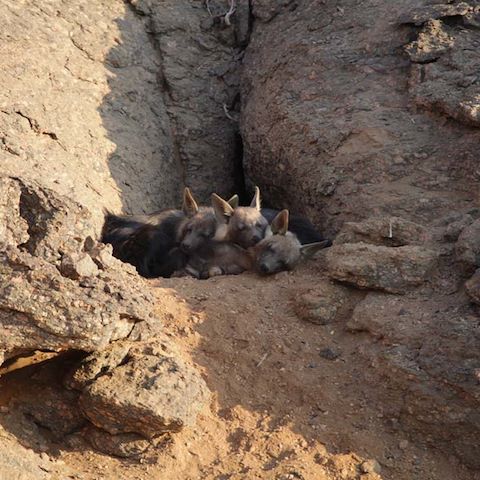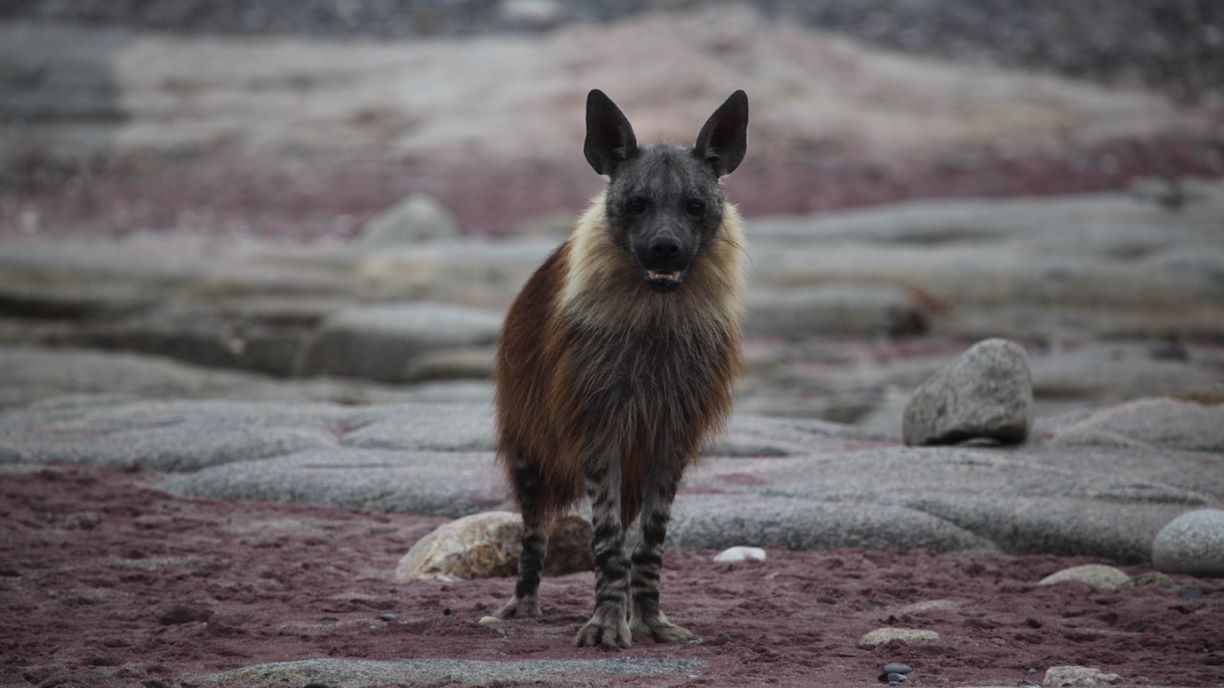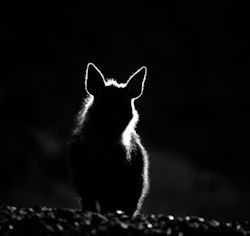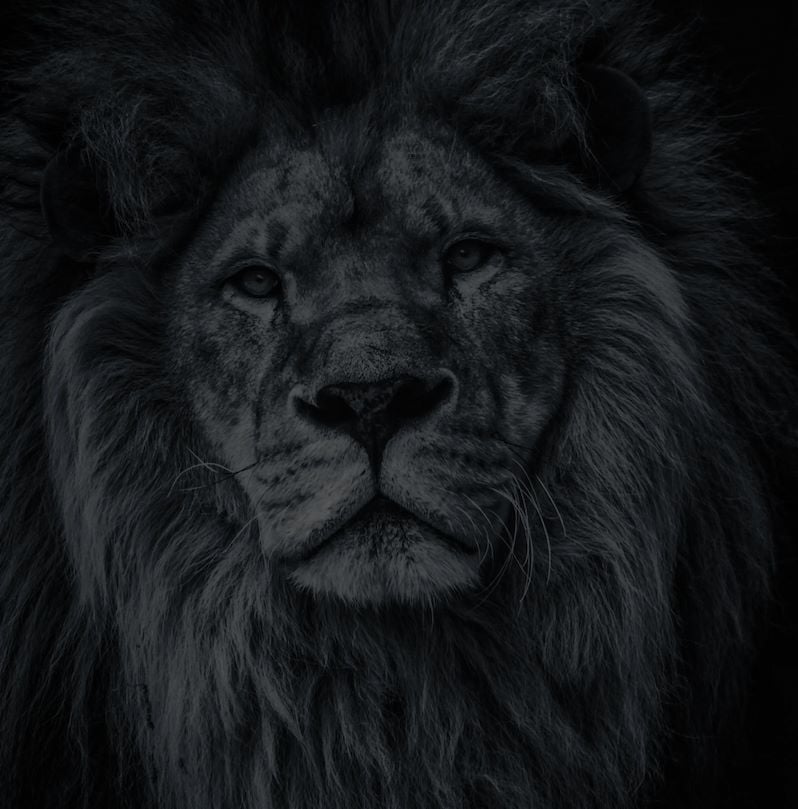World Hyena Day 2024

This month, as we celebrate World Hyena Day, I’m reminiscing about the first time I saw a brown hyena, 15 years ago when I was on a camp visit as an Area Manager at the old Wilderness Skeleton Coast Camp. I was on an early morning walk in the dry Khumib riverbed and it was a typical Skeleton Coast morning: quiet, cold, wet from the thick layer of fog. A little mystical.
The hyena silently, suddenly, appeared through the fog and I was petrified, frozen on the spot. Time stood still as I watched the hyena with bated breath. It was a lot bigger than I expected, it had beautiful big brown eyes and its shaggy coat was wet from the fog. I could see little droplets on its face and lashes. It vanished in the fog as quietly as it appeared and I could only hear soft crunching on the gravel as it walked away from me. I was shaking a little, both from excitement and fright. My very first brown hyena sighting, and on foot.
I knew very little of these scavengers then, and I would come to learn later that this is what they do. They don’t arrive, they appear.
Brown hyenas vs. spotted hyenas
Most people are not even aware that brown hyenas exist, being more familiar with the spotted hyena. The spotteds are essentially the ‘face’ of the Hyaenidae family, which actually consisting of 4 species: spotted hyena, brown hyena, striped hyena and aardwolf. Here are some differences between these two types of hyenas:
- Spotted hyenas are bigger than brown hyenas and have a matriarchal (female dominated) hierarchy compared to the linear hierarchy (dominant male and female) of the brown hyenas.
- Spotted females have a pseudo penis and are bigger than the males, whereas brown hyenas have normal female genitalia and there is no big size difference between males and females.
- Spotted hyenas are very vocal; they communicate animatedly and make the typical ‘whoop’ call that you associate with the night sounds of Africa. Brown hyenas are quiet and secretive, they don’t have long distance vocalisations.
- Spotted hyenas are not the revolting scavengers they are made out to be in Disney’s Lion King. They are actually very successful hunters, whereas brown hyenas are predominantly scavengers. Both hyenas are, however, opportunists and will take a free meal when possible.
- Spotted hyena clans are much bigger than brown hyena clans. Spotteds are also very successful and are the most abundant large carnivore in Africa (estimated between 27,000 – 45,000), whereas brown hyena is the rarest of the Hyaenidae family with a global estimate of between 5,000 – 8,000.
To see a brown hyaena is truly special. As secretive, solitary scavengers mostly active at night, the only signs they leave behind for the morning light, are footprints.

Catching brown hyenas on camera
In 2009, while on a camp visit to Wilderness Hoanib Skeleton Coast Camp, I put out a camera trap at a potential den site in the ephemeral Hoanib River. The result – photos of a brown hyena female with two cubs that changed my life and ultimately led to a monitoring project, supported by Wilderness, in the north-west of Namibia.
I could, however, only visit this den site sporadically throughout the next few years. As Area Manager for the north-western camps of Wilderness Namibia, I was permanently based at Wilderness Desert Rhino Camp and only visited the Hoanib area every few months.
However, I returned permanently to the Hoanib River in 2014 as Research Co-ordinator. Wilderness Hoanib Skeleton Coast Camp was being rebuilt and would include facilities to host visiting researchers, as well as a small research centre. Here, I would assist students and researchers making use of the facilities. Luckily, the den was still in use by the same female from 2009 and I started with more regular observations.
Understanding brown hyenas in Namibia
While brown hyenas belong to clans, because they are mainly scavengers, they forage on their own. They are, however, quite social at active dens, but we see so little of this because the dens are so well hidden. Thus, the Hoanib clan became pivotal in my subsequent understanding of brown hyena ecology and behaviour. They are still one of my favourite clans and it has been an immense privilege and pleasure to be part of their lives for so long. The breeding female of 2009 – 2014, Joey (Xhb-19), who was quite old by then, died of natural causes in March 2015. Stevie (Xhb-21) was the next in line as the breeding female and had her first litter in November of 2015. She is still the breeding female of the Hoanib clan and is a very successful and dedicated female.
Today my research concentrates on three neighbouring clans in the Hoanib River, living in contrasting habitats (coastal, floodplain, arid desert). I collect baseline data on brown hyena ecology and demography, trying to gain a better understanding of how their specific habitats influence movement, home range patterns, dietary preferences, population dynamics and genetic diversity. I assist and collaborate with various NGOs, educational and governmental institutions and affected stakeholders for the long-term conservation, systems development, monitoring, management and conflict mitigation of this lesser-known species.
Education and awareness have also become an important part of my research. False beliefs and fear are rife. People are afraid of getting attacked by brown hyenas, are afraid of getting diseases from brown hyenas and believe that brown hyenas are successful livestock killers, but this rarely happens.
Brown hyenas are the least studied of the large carnivores and there is still a lot to learn about this elusive species. In the north-west of Namibia there had not been any research on the brown hyena before this study. The more we know, the better we can manage our impact on this species and speak out for them.
Brown hyena observation methods
- Visual observations – opportunistic sightings, food sources like a seal colony and carcasses, interactions at active den sites
- Camera traps – camera traps are deployed in various places like active dens, communal latrines, carcasses and pathways that hyenas frequent
- GPS collars – the breeding female of each clan, as well as younger females, are collared. Although unsightly, collars are an important tool to collect data remotely. We can study activity patterns, home ranges, clan dynamics etc. Collars are replaced on average every two and a half years. With technology getting better, collars are getting smaller and lighter as we speak.
Over the past years I have come to know brown hyenas as highly intelligent, resourceful, resilient and adaptable. I have been outsmarted by them more times that I would care to admit. They are more social and caring than we think, and I have seen females walk many a difficult mile in treacherous conditions to suckle cubs. As cleaners they are vital to a healthy and balanced ecosystem.
Hyenas deserve our respect, acceptance and a more objective attitude towards them as an important piece of the circle of life, that we are all part of. So next time – stop, and spend some time with a hyena if you can. Keep an open mind and heart, and be prepared to be amazed, amused, or at least look at them a little differently.
A visit to Wilderness Hoanib Skeleton Coast could treat you to an amazing sighting
A visit to Wilderness Hoanib Skeleton Coast could treat you to an amazing sighting


Let’s plan your next journey
Ready?
When we say we’re there every step of the way, we mean it, literally. From planning the perfect circuit, to private inter-camp transfers on Wilderness Air, and easing you through Customs. We’re with you on the ground, at your side, 24-7, from start to finish. Ready to take the road less travelled? Contact our Travel Designers to plan an unforgettable journey.